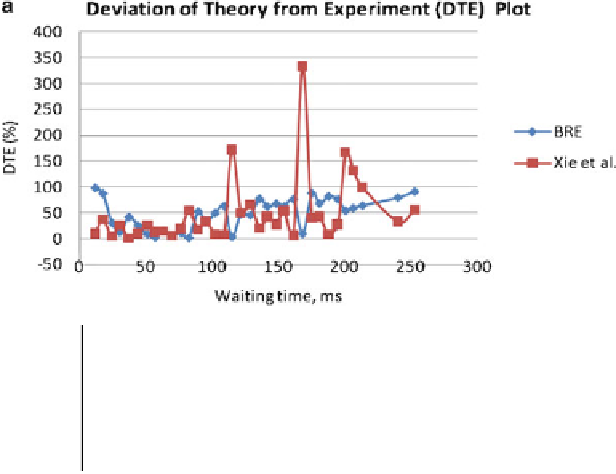Biology Reference
In-Depth Information
a
b
Parameters
BRE
Xie et al.
Mean DTE (%)
49.0
49.5
Standard Deviations
30.5
65.9
Coefficient of variations (CV)
62.2
133.2
Fig. 11.27 The deviation of theory from experiment (DTE), the distances between the waiting
times measured and those predicted as defined by Eq. 11.35. (a)(
Diamond
) Calculations were
performed using the blackbody radiation-like equation (BRE) given in Eq.
11.27
with X(w)
¼
0.
(
Square
) Calculations based on the distances between the measured and predicted values read off
from Fig. 1d in Xie and Lu (1999). (b) A statistical comparison between the BRE and Xie et al.
models
for
11.27
(see the table in Fig.
11.27b
), indicating that BRE fits the single-molecule
enzymological data better than the bi-exponential function of Lu et al. (1998).
The results shown in Fig.
11.27
indicate that Eq.
11.27
derived on the basis of the
analogy between blackbody radiation and enzymic catalysis is superior to Eq.
11.25
derived on the basis of the Michaelis-Menten mechanism (Lu et al. 1998).
The interesting question that now arises is:
What is the theoretical rationale, if any, for the apparent analogy between blackbody
radiation and enzymic catalysis? (11.38)
The most important reason for the similarity between
blackbody spectrum
and
the
waiting time distribution
of COx may be traced to the fact that both the
blackbody wall and the enzyme molecule consist of
systems of molecular
oscillators
(see Row 2 in Table
11.9
). A blackbody is a system of approximately
10
27
oscillators that are vibrationally and electronically excited from their common
ground-state energy level, E
0
, to various excited states denoted as E
i
, where i runs
from 0 to n, the total number of energy levels available to each oscillator (see the
left panel in Fig.
11.28
). On the other hand, the COx molecule is a system of about
10
5
atoms linked to form a three-dimensional network of covalent bonds forming









